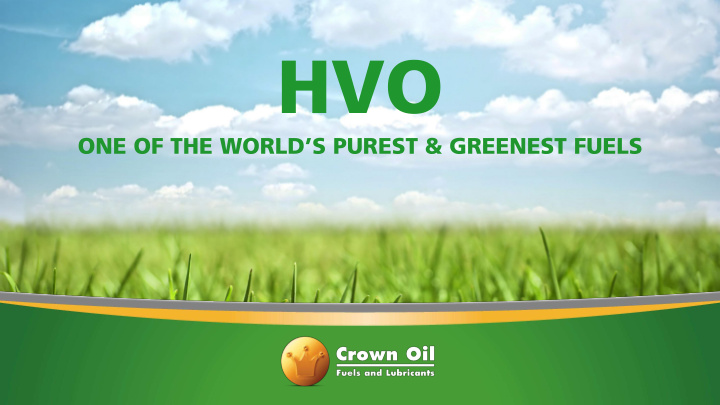



HVO ONE OF THE WORLD’S PUREST & GREENEST FUELS
Synthetic paraffinic fuel Manufactured from 100% renewable raw materials Complies to the EN 15940 standard Replacement drop-in for mineral diesel What is HVO?
EN 15940:2016 ASTM Property Crown HVO EN 590:2018 Class A D975:19b Crown HVO meets the requirements of EN Appearance at +25 °C Clear & Bright 15940:2016. This standard was developed to control Cetane number > 70.0 ≥ 70.0 ≥ 51.0 ≥ 40 820.0…845.0 the quality of Fischer-Tropsch paraffinic diesel fuels Density at +15 °C kg/m 3 770.0…790.0 765.0…800.0 ≥ 800.0 * such as HVO and GTL. Total aromatics % (m/m) < 1.0 ≤ 1.1 ≤ 35 Polyaromatics % (m/m) < 0.1 ≤ 8.0 These fuels are typically characterised by: Sulfur mg/kg < 5.0 ≤ 5.0 ≤ 10.0 ≤ 15 • FAME-content % (V/V) 0 ≤ 7.0 ≤ 7.0 Greater CETANE number vs EN 590 diesel fuels • Flash point °C > 61 > 55 > 55 > 52 Lower aromatics and polyaromatics Carbon residue on 10 % • Lower sulphur % (m/m) < 0.10 ≤ 0.30 ≤ 0.30 ≤ 0.35 distillation • Increased oxidation stability and storage longevity Ash % (m/m) < 0.001 ≤ 0.010 ≤ 0.010 ≤ 0.01 • Clean burn and reduced emissions profile Water mg/kg < 200 ≤ 200 ≤ 200 Total contamination mg/kg < 10 ≤ 24 ≤ 24 Water and sediment % (V/V) ≤ 0.02 ≤0.05 Copper corrosion Class 1 Class 1 Class 1 Class 3 ≤ 25 ≤ 25 Oxidation stability g/m 3 h < 25 ≥ 20 ** ≥ 20 ** Lubricity HFRR at ≤ 460 μm ≤ 460 ≤ 460 ≤ 520 +60 °C 2.000 … 4.500 Viscosity at +40 °C mm 2 /s 2.00 … 4.00 2.000 … 4.500 1.9…4.1 ≥ 1.200 * Distillation 95%(V/V) °C < 320 ≤ 360 ≤ 360 90% (V/V) °C 282 … 338 282…338 Final boiling point °C < 330 Cloud point and CFPP As needed °C As in EN 590 Down to -34 ***** - 5… -34 Antistatic additive Added Conductivity pS/m ≥ 50 ≥ 25 HVO Mineral Diesel Technical standards and performance
Renewable Sustainable Up to 90% reduction in greenhouse gas emissions (GHG) Biodegradable What are the benefits of HVO?
HVO burning results in a 90% reduction in permanent CO 2 emitted to the atmosphere Mineral diesel - 100% GHG HVO CO2 cycle emission 1 tonne of fuel = 3 tonnes of CO2
• Renewability is a measure of how much a resource can be used repeatedly and replaced naturally • Crown HVO is 100% renewable. It is manufactured from plant and animal oils/fats, which can be regrown when new feedstock is needed HVO is renewable because… …It’s made of this ….and not this • Sustainability in the context of fuel production can be defined as the ability to continue to produce the product without damaging the environment • Therefore the crops used to manufacture HVO do not damage the environment, do not use land which has been clamed from other use (rain forest etc) and does not displace animals or other key aspects of the natural ecosystem • Palm oil is a classic example of a renewable, but unsustainable resource Renewability and sustainability
Excellent low temperature stability Very low pour point / CFPP Extended shelf life – 10 years No oxygen or aromatics Reduction in NOx, PM and CO Totally miscible with diesel/gas oil In all proportions - no need to run down the storage tank contents before changeover HVO – Features and Benefits
Virtually sulphur free Reduction in sulphur level compensated for by careful component selection Lubricity levels boosted to protect fuel pumps Can be additive treated Provides fuel system cleanliness & corrosion protection & reduced emissions The same hazard class as regular gas oil Conforms to the same transport regulations HVO – Features and Benefits
Approvals from a number of OEMs HVO – In the market HVO – In the market
Recommend